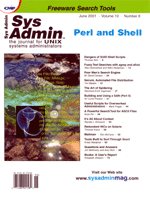 Books:
A User's Report Books:
A User's Report
Elizabeth Zinkann
The different backgrounds and levels of expertise within the UNIX
community provide us with rich and varied resources. Coincidentally,
this month's column reflects that diversity, with book reviews
on an alternative Web browser, a book for UNIX novices, a Linux
administrator's guide, and a book about affiliate partnerships.
Specifically, the reviews include: The Opera 5.x Book: Browsing
the Web with Speed and Style by J. S. Lyster, (No Starch Press);
Think Unix by Jon Lasser (Que); Red Hat Linux Administrator's
Handbook, Second Edition by Mohammed J. Kabir (M & T Books/Hungry
Minds Books); and The Complete Guide to Associate and Affiliate
Programs on the Net by Daniel Gray (McGraw-Hill).
Reviewer's Note: The copy of the Opera book that I reviewed
was an advance copy and in manuscript format. The final bound edition
may differ in page length due to typesetting and graphics layouts.
--ez
The Opera 5.x Book: Browsing the Web with Speed and
Style
J. S. Lyster
Foreword by Jon S. von Tetzchner, CEO, Opera Systems
No Starch Press
ISBN 1-886411-47-6
297 Pages
$29.95
CD-ROM Included
http://www.nostarch.com/
A browser provides a user's access to the Web and, in many
cases, also acts as an email client. The two most popular browsers
are Microsoft's Internet Explorer and Netscape's Navigator.
An alternative choice is the Opera Web browser, which features many
capabilities missing in both Explorer and Navigator. Opera takes
less space, doesn't load plug-ins until you need them, possesses
full windowing capabilities (so that you can actually work in two
or more windows without draining your system's resources),
and can save your work until a later date.
One of Opera's strengths is its keystroke alternative. Many
users either cannot use a mouse or prefer to use it sparingly. Opera
allows the user to rely more on keyboard navigation than on mouse
clicks. It also allows cookie options and filters, presentation
and kiosk development, and provides Web designers with an ideal
testing facility. Because Opera follows the W3C (World Wide Web
Consortium) guidelines, the same appearance of a Web page will usually
have same appearance in Explorer and Navigator. These (and many
more) facets of the Opera Web browser are superbly described and
demonstrated in The Opera 5.x Book: Browsing the Web with Speed
and Style by J. S. Lyster. The author discusses Opera's
installation, basic navigation, toolbars, and its more advanced
qualities in a step-by-step format.
Lyster approaches the different topics through seven sections:
Installation, You've Got Mail, Supercharging Your Browser,
Power-Surfing, Going Further, Beyond the Browser, and Alternative
Operating Systems plus the Appendices. In Part One, Installation,
Lyster presents Getting Started, Surfing In Style, The Software
Side of the Net, and Customizing the Browser. In the second part,
You've Got Mail, the author discusses Setting Up Email and
Instant Messaging, Managing Your Mail, and Newsgroups. Supercharging
Your Browser details Adding Java Support, Using External Applications
and Plug-Ins, Multimedia: Getting the Most Out of Images and Sound,
and Three Utilities That Expand Your Reach. The following section,
Power-Surfing, examines Keeping Your Hands on the Keys, Unlocking
Opera's Powers, and Privacy and Security; Part Five: Going
Further, explains Network Administration and Multiple Users, Extreme
Customization, and Opera as a Workhorse. The concluding parts, Beyond
the Browser and Alternative Operating Systems survey Completing
Your Toolkit, Beyond Windows 95 and 98, and Opera for Linux: The
New Frontier, respectively. The Appendices include: A) Keyboard
Commands and Shortcuts, B) Guide to the Compact Disc, C) Technical
Specifications, and D) Learning About the Web. The accompanying
CD-ROM contains Opera for all platforms, the utilities described
in the book, and plug-ins (where applicable).
I have been an Opera enthusiast since I realized how much faster
it was than other browsers. In The Opera 5.x Book: Browsing the
Web with Speed and Style, J. S. Lyster illustrates Opera's
capabilities and discusses its possible configurations. The examples
are primarily for the Windows 95+ user. However, most of the procedures
apply to every platform. BeOS, EPOC, and Windows 3.1 users should
read Chapter 19 first; the Linux installation differences are described
in Chapter 20. In these two chapters, Lyster reviews the idiosyncrasies,
limitations, and workarounds for the other operating systems implementations.
The rest of the book discusses guidelines and procedures for all
platforms, with few exceptions. Lyster's book is a well-written
companion to the features of the Opera Web browser. Users will appreciate
his proficient and extensive description of Opera's myriad
capabilities and dimensions.
Think Unix
Jon Lasser
Que
ISBN 0-7897-2376-X
290 Pages
$29.99
http://www.quepublishing.com/
Every operating system or computing environment utilizes its own
set of commands or processes. When developers or users move from
one environment to another, they often feel that they've completely
changed countries without the benefit of a translator. This is particularly
evident when they move from a non-UNIX, non-command line system
to a UNIX environment. Originally, a developer's operating
system, the documentation, and commands were logical to developers,
who also used a permuted index. These procedures and explanations
are often not quite as evident to the new UNIX user, even when the
user has a computing background.
Most beginning books are written for the complete novice, not
for someone who knows a computer system other than UNIX. To address
this forgotten audience, Jon Lasser has written Think Unix.
He discusses the way that the UNIX system works and attempts to
describe how the UNIX community thinks. Lasser examines the topics
through four sections: UNIX Concepts, Shell Concepts, X Window System
Concepts, and the Appendices. In the first section, UNIX Concepts,
Lasser details UNIX Documentation, Files and Processes, Redirection
and Pipes, Networking, and vi, Dotfiles, and Regular Expressions.
Shell Concepts contains Muddling Through Shells, Variables and Quoting,
Conditional Execution and Loops, and Shell Scripts and More. The
X section, X Window System Concepts, analyzes Thinking Like X and
Configuring X; Appendices includes: A) Answers to Practice Problems,
B) Glossary and References, and the Index.
As Lasser explains the topics and demonstrates how to create files
or change directories or group and use filters, he reinforces the
principles discussed with sets of practice problems. He also addresses
the various topics with a sense of humor, even through the footnotes.
When a technique or procedure doesn't follow an expected pattern,
or seem to make sense (at least from the learner's viewpoint),
he clearly states that it doesn't, even though that is the
accepted way it is done. Lasser explains the concepts and their
accompanying implementations clearly, illustrates their use through
numerous examples, and reinforces the processes used in a very clear
style. This is an excellent book that any UNIX novice can appreciate.
Red Hat Linux Administrator's Handbook
Second Edition
Mohammed J. Kabir
M & T Books
ISBN 0-7645-4797-6
693 Pages
$24.99
http://www.mandtbooks.com/
http://www.hungryminds.com/
The original Red Hat Linux Administrator's Handbook
covered the distributions through 6.1. The newly released second
edition updates the material to reflect changes through Red Hat
7.0. The approach remains the same; this book is a quick and thorough
reference for systems administrators. Kabir presents the material
through three sections. The initial part, Installation and Basic
Configuration, addresses Getting Started, Boot Up and Shutdown Configuration,
File Permissions, and Using Linuxconf. The central part of the book,
Advanced Configuration, concentrates on User Administration, Process
Administration, Network Administration, DNS Service, E-mail Service,
FTP Service, Sharing Files and Printers with Samba, Web Service
Using Apache, Using NFS File Servers, and Configuring X Windows.
These chapters illustrate how to set up your server to accomplish
the more complex and most essential tasks. The final section, Troubleshooting,
analyzes the problems that can occur, demonstrates how to protect
your system against intrusion through chapters on Security and Network
Security and also details how to keep your system current with a
chapter on Customizing the Kernel. The Appendices contain A) Common
Commands and B) Linux Resources.
Kabir is a superb author with demonstrated expertise with Apache,
Samba, server installation, and network installation. He writes
clearly and demonstrates server installation and configuration in
an effective manner. This is an essential utility for every Linux
systems administrator.
The Complete Guide to Associate and
Affiliate Programs on the Net
Daniel Gray
McGraw-Hill
ISBN 0-07-135310-0
228 Pages
$19.95
http://www.books.mcgraw-hill.com
Whether it's a single frame, or one of several banners in
a row, the appearance of advertisements for other sites has become
common practice. Participants are not limited to commercial sites;
individuals are also encouraged to join associate or affiliate partnership
programs. In The Complete Guide to Associate and Affiliate Programs
on the Net, author Daniel Gray explains what the partnership
programs involve, issues to consider before becoming an associate
or affiliate, some success stories, and the top merchants. The author
addresses the topics in the following order: Why Become an Associate
or Affiliate?, Building Your Affiliate Site, Search Engine Tuning,
Keeping Track, Merchant Profiles, Affiliate Success Stories, and
The Top 100 Directory. Within the chapters, Gray demonstrates how
to select the right affiliate partnerships for your site, lists
pertinent affiliate-related resources, and suggests effective page
designs. The importance of careful selection and page design cannot
be overemphasized. Many sites clutter their pages with affiliate
banners and obscure the primary information onthe page. Conflicting
partnerships can also become a problem. Gray details the importance
of keeping statistics in addition to the legal responsibilities
of an affiliate, including taxes.
With The Complete Guide to Associate and Affiliate Programs
on the Net, author Daniel Gray presents realistic information
and expectations for anyone considering an affiliate partnership.
He examines the practices and procedures that every would-be affiliate
should follow. This is an excellent reference and required reading
for anyone about to establish an associate/affiliate partnership.
Elizabeth Zinkann has been involved in the UNIX and C environment
for the past 15 years. She is currently a UNIX and C consultant,
and one of her specialties is UNIX education. In addition to her
computer science background, she also has a degree in English. Her
writing has also appeared in Linux Magazine, Performance
Computing, and Network Administrator. Elizabeth can be
reached at: elizabeth@equillink.com.
|

